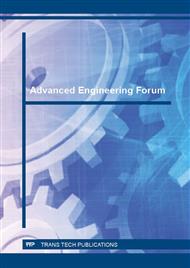[1]
D. K. Pal and S. K. Basu, Hot machining of austenitic manganese steel by shaping, International Journal of Machine Tool Design and Research, vol. 11, (1971)45-61.
DOI: 10.1016/0020-7357(71)90046-1
Google Scholar
[2]
N.N.S. Chen and K.C. Lo, Factors affecting tool life in hot machining of alloy steels, International Journal of Machine Tool Design, vol. 14, (1974)161-173.
DOI: 10.1016/0020-7357(74)90024-9
Google Scholar
[3]
V. Roughuram and M.K. Mujo, Improving tool life by magnetization in hot machining, Machine Tool Design and Research, (1980) 87–96.
Google Scholar
[4]
B.K. Hinds and S.M. DE Almedia, Plasma archeating for hot machining, International Journal of Machine Tool Design, Vol. 21, (1981) 143-152.
DOI: 10.1016/0020-7357(81)90005-6
Google Scholar
[5]
T. Kitagaea and K. Maekawa, Plasma hot machining for new engineering materials, Wear, vol. 139, (1990) 251-267.
DOI: 10.1016/0043-1648(90)90049-g
Google Scholar
[6]
G. Madhavulu and B. Ahmed, Hot machining process for improved Metal Removal Rates in turning operations, Journal of Materials Processing Technology, vol. 44, (1994) 199-206.
DOI: 10.1016/0924-0136(94)90432-4
Google Scholar
[7]
N. Tosum and L. Ozler, Optimisation for hot turning operations with multiple performance characteristics, International Journal of Advanced Manufacturing Technology, vol. 23, (2004) 777-782.
DOI: 10.1007/s00170-003-1672-4
Google Scholar
[8]
Carl E. Leshock, Jin-Nam Kim and Yung C. Shin, Plasma enhanced machining of Inconel 718: modeling of work piece temperature with plasma heating and experimental results, International Journal of Machine Tools & Manufacture , vol. 41, (2001).
DOI: 10.1016/s0890-6955(00)00106-1
Google Scholar
[9]
Ozler, L., Inan, A. and Ozel, C., Theoretical and experimental determination of tool life in hot machining of austenitic manganese steel, International Journal of Machine Tool and manufacturing, vol. 41, ( 2000) 163–172.
DOI: 10.1016/s0890-6955(00)00077-8
Google Scholar
[10]
N. Tosun and L. Ozler, A study of tool life in hot-machining using artificial neural networks and regression analysis method, Journal of Material processing technology, vol. 124, (2002) 99-104.
DOI: 10.1016/s0924-0136(02)00086-9
Google Scholar
[11]
N. Tosun and L. Ozler, Optimization for hot turning operations with multiple Performance characteristics, International Journal of Advanced Manufacturing Technology, vol. 23, (2004) 777–782.
DOI: 10.1007/s00170-003-1672-4
Google Scholar
[12]
Davim J.P. and Antonio C.A.C., Optimal drilling of particulate metal matrix composites based on experimental and numerical procedures, International Journal of Machine Tool and manufacturing, vol. 41, (2001) 21–31.
DOI: 10.1016/s0890-6955(00)00071-7
Google Scholar
[13]
K.P. Maity and P.K. Swain, An experimental investigation of hot machining to predict tool life, Journal of Materials Processing Technology, vol. 198, (2008) 344–349.
DOI: 10.1016/j.jmatprotec.2007.07.018
Google Scholar
[14]
M.A. Lajis, A.K.M. Nurul Amin, A.N. Mustafizul Karim, Turnad L. Ginta and H.C.D. Mohd Radzi, Hot Machining of AISI D2 Hardened Steel with Coated Carbide Inserts, American Journal of Engineering and Applied Sciences, vol. 2, (2009) 421-427.
DOI: 10.3844/ajeassp.2009.421.427
Google Scholar
[15]
S. Ranganathan and T. Senthilvelan, Optimizing the process parameters on tool wear of WC insert when hot turning of AISI 316 stainless steel, ARPN Journal of Engineering and Applied Sciences, (2010).
Google Scholar
[16]
S. Ranganathan and T. Senthilvelan, Multi-response optimization of machining parameters in hot turning using Grey analysis, International Journal of Advanced Manufacturing Technology, vol. 56, (2011) 455-462.
DOI: 10.1007/s00170-011-3198-5
Google Scholar
[17]
Nikunj R Modh, G. D. Mistry and K. B. Rathod, An experimental investigation to optimize the process parameters of AISI 52100 steel in hot machining, International Journal of Engineering Research and Applications, Vol. 1, (2011). 483-489.
Google Scholar
[18]
Nirav M. Kamdar and Vipul K. Patel, Experimental Investigation of Machining Parameters of EN 36 Steel using Tungsten Carbide Cutting Tool during Hot Machining, International Journal of Engineering Research and Applications, Vol. 2, (2012).
Google Scholar


